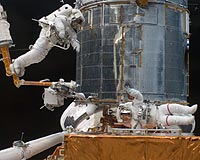 |
Paris, France (ESA) Apr 12, 2010 Hubble has snapped a spectacular view of the largest "player" in the Leo Triplet, a galaxy with an unusual anatomy: it displays asymmetric spiral arms and an apparently displaced core. The peculiar anatomy is most likely caused by the gravitational pull of the other two members of the trio. The unusual spiral galaxy, Messier 66, is located at a distance of about 35 million light-years in the constellation of Leo. Together with Messier 65 and NGC 3628, Messier 66 is one third of the Leo Triplet, a trio of interacting spiral galaxies, part of the larger Messier 66 group. Messier 66 wins out in size over its fellow triplets - it is about 100 000 light-years across. Messier 66 is the proud owner of exclusive asymmetric spiral arms which seem to climb above the galaxy's main disc and an apparently displaced nucleus. This asymmetry is unusual; most often, dense waves of gas, dust and newly born stars wind about the galaxy's centre in a symmetric way. Astronomers believe that Messier 66's once orderly shape has most likely been distorted by the gravitational pull of its two neighbours. Hubble has imaged Messier 66's striking dust lanes and bright star clusters along the spiral arms in fine detail with the Advanced Camera for Surveys. Star clusters - pictured in the blue and pinkish regions of the image - are key tools for astronomers since they are used as indicators of how the parent galaxies assembled over time. Messier 66 boasts a remarkable record of supernovae explosions. The spiral galaxy has hosted three supernovae since 1989, the latest one occurring in 2009. A supernova is a stellar explosion that may momentarily outshine its entire host galaxy. It then fades away over a period lasting several weeks or months. During its very short life the supernova radiates as much energy as the Sun would radiate over a period of about 10 billion years.
Share This Article With Planet Earth
Related Links Hubble at ESA Space Telescope News and Technology at Skynightly.com
 Zen And The Art Of Space Maintenance
Zen And The Art Of Space MaintenanceLos Angeles CA (SPX) Mar 25, 2010 The challenge for the makers of Hubble 3D was how to somehow turn repairing a twenty year old beat-up piece of space technology into a dramatic and compelling story for a broad audience. Of course that piece of the technology inserted as the main character of the story is the several billion dollar Hubble Space Telescope that has a long and controversial history, beset by programmatic dela ... read more |
|
| The content herein, unless otherwise known to be public domain, are Copyright 1995-2010 - SpaceDaily. AFP and UPI Wire Stories are copyright Agence France-Presse and United Press International. ESA Portal Reports are copyright European Space Agency. All NASA sourced material is public domain. Additional copyrights may apply in whole or part to other bona fide parties. Advertising does not imply endorsement,agreement or approval of any opinions, statements or information provided by SpaceDaily on any Web page published or hosted by SpaceDaily. Privacy Statement |